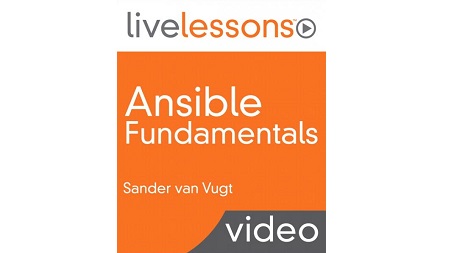
English | MP4 | AVC 1280×720 | AAC 44KHz 2ch | 2h 56m | 1.33 GB
Ansible Fundamentals LiveLessons provides a quick introduction to Ansible for administrators and developers who want to get started in a fast and easy way without spending too much time on details. Since it was first released, Ansible has become one of the most used systems for configuration management. This course covers key fundamental topics, so you can get up and running quickly.
The course starts with an introduction to working with Ansible, including essential configuration to get you started as quickly as possible. You then learn about Ansible architecture and essential Ansible components, including playbooks, variables, task control, flow control, conditionals, and Jinja2 templates. Every lesson ends with a lab and lab solution, so you can see firsthand how to use Ansible in your own work.
This course can also be used as a secondary resource to get you started studying for the Red Hat Certificate of Expertise in Ansible Automation (exam 407).
Learn How To
- Get started with Ansible
- Understand Ansible architecture
- Work with playbooks
- Work with variables, inclusions, and task control
- Use flow control, conditionals, and Jinja2 templates
Who Should Take This Course
- IT professionals
- System administrators
- Developers
- Red Hat professionals
Course Requirements
To run the labs in this course, two virtual machines with a Linux installation are required. Using CentOS 7.3 or higher is recommended.
Lesson descriptions
Lesson 1 demonstrates how to get started with Ansible. Get up and running as fast as possible. Run some tasks using Ansible to understand what it is doing and how it is doing it.
Lesson 2 covers Ansible architecture and the different components that are typically involved in an Ansible environment. Understand how to run a successful Ansible deployment, and learn about modules, which are probably the most important parts of Ansible; they enable you to do anything in an Ansible environment.
Lesson 3 covers Ansible playbooks. A playbook contains the instructions that are needed to run tasks in an Ansible environment, and they are written in the YAML format. Get started with YAML and create and run playbooks.
Lesson 4 demonstrates how to work with variables, facts, and inclusions. All of these make Ansible more flexible. By using these different components, you can apply parameters in a flexible way even if the configuration might change.
Lesson 5 discusses more items that make Ansible such a flexible solution. Work with flow control in an Ansible environment, look at using conditionals, and create some templates. These items make it possible to easily apply host-specific parameters in configuration files and in a flexible way.
Table of Contents
01 Ansible Fundamentals LiveLessons – Introduction
02 Learning objectives
03 1.1 Understanding the Benefits of Using Ansible
04 1.2 Installing Ansible
05 1.3 Managing Inventory
06 1.4 Creating the Ansible Config File
07 1.5 Running Ansible Ad-hoc Commands
08 1.6 Adding a Managed Host
09 1.7 Lesson 1 Lab – Running Ad-hoc Commands
10 1.8 Lesson 1 Lab Solution – Running Ad-hoc Commands
11 Learning objectives
12 2.1 Ansible Architecture Overview
13 2.2 Running Ansible Deployments
14 2.3 Working with Modules
15 2.4 Lesson 2 Lab – Exploring Ansible Modules
16 2.5 Lesson 2 Lab Solution – Exploring Ansible Modules
17 Learning objectives
18 3.1 Creating YAML Files
19 3.2 Creating Playbooks
20 3.3 Running Playbooks
21 3.4 Lesson 3 Labs – Working with Ansible Playbooks and Preparing OpenStack Hosts
22 3.5 Lesson 3 Lab 1 Solution – Working with Ansible Playbooks
23 3.6 Lesson 3 Lab 2 Solution – Preparing OpenStack Hosts
24 Learning objectives
25 4.1 Working with Variables
26 4.2 Managing Host Variable and Group Variables
27 4.3 Using Facts
28 4.4 Using Inclusions
29 4.5 Lesson 4 Lab – Working with Variables, Inclusions, and Task Control
30 4.6 Lesson 4 Lab Solution – Working with Variables, Inclusions, and Task Control
31 Learning objectives
32 5.1 An Introduction to Flow Control
33 5.2 Working with Conditionals
34 5.3 Working with Jinja2 Templates
35 5.4 Lesson 5 Lab – Working with Jinja2 Templates
36 5.5 Lesson 5 Lab Solution – Working with Jinja2 Templates
37 Ansible Fundamentals LiveLessons – Summary
Resolve the captcha to access the links!